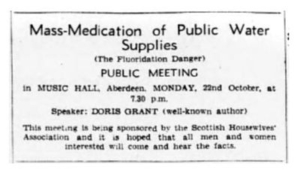Doris Margaret Louise Grant (née Cruickshank)
Nutritionist
Photo of Doris Grant from the dust jacket of Dear Housewives, 1954
- BORN 23rd January 1905, Alvah, Banff, Scotland
- DIED 27th February 2003, Stevenage, Hertfordshire, England
- WORKED London, England; Northwood, Middlesex, England
- HONOURS None known, despite being a very influential and well-known natural food campaigner for many years
- MINERVA SCIENTIFICA PROJECT Minerva Scientifica 2021 Birthday Celebrations
Entry by Catherine Booth
Artistic Connections
She was from a musical family – her father, a farmer, was also an amateur violinist who often judged local musical competitions. Doris’s husband and daughters played stringed instruments, which inspired her to take up the cello in adult life. She had artistic talents too – designing and making costume jewellery, and illustrating some of her own publications.
Music
Title: No Need To Knead
Composer: FRANCES M LYNCH
Words: Compiled from Doris Grant quotes; an advert for flour in the Dundee Courier (Tues 27th Oct 1953) and a recipe for the Grant Loaf by Catherine Booth
Written: January 21st – 22nd 2021
For: String quartet, speaker and 2 female voices
Performed by: Frances M Lynch – voices; we were unable to record the strings so for now they are realized on a digital keyboard – we hope to update soon (Covid permitting)
Imagine the Grant family string quartet playing in their living room while the aroma of fresh bread fills the air as a Grant Loaf gently bakes in the oven. The voices, in Doris’s head, are going over the ingredients – yeast, salt, flour, honey and water – and ruminating on the “chemical dragons” of chalk, pesticides and agene – beware the “murdered bread” (white bread!).

Glasgow School of Art (Image by stevecadman on flickr, Licence: Creative Commons Attribution-Share Alike 2.0 Generic)
Education
School at Banff Academy; 5 year Diploma at Glasgow School of Art, for which she was nominated as top student of her year.
Occupations
Healthy eating advocate
As a young woman, Doris Grant suffered from chronic ill health caused by rheumatoid arthritis. A cousin, who was a doctor, suggested she look to her diet. She discovered the ‘Hay Diet’, developed in the 1920s by an American physician, Dr William Howard Hay. The main principle of the diet stipulated that you should avoid combinations of certain types of food, and eat different food groups at different times. Adoption of this diet improved her health enormously. The experience prompted her to examine nutrition and its effects on health. She became a strong advocate of natural and whole foods, fresh and unprocessed, and little or no sugar. Conviction that this was the healthiest way to live became a lifelong passion, strengthened by her own research and anecdotal evidence from others.
Author
In 1936-1937, Doris Grant wrote a regular column in the Sunday Graphic, where she published her ideas on healthy eating, including experiences from correspondents. Having met Dr Hay, she wrote her first book, The Hay System Menu Book, published in 1937, which laid out the principles of the diet, along with recipes aimed at a British audience. Several other books on healthy eating followed, often produced in multiple editions over several years, such as: Feeding the Family in Wartime (1942); Your Daily Bread (1944); Housewives beware (1958) and, with co-author, Jean Joice: Food Combining for Health (1984), which became a classic, selling over a million copies worldwide.

A selection of images of the front cover of some of Doris Grant’s books
Baker and cook
Doris Grant’s books made her very well-known, and called on her to be a frequent speaker at meetings. She was also an experienced home baker and cook. Today she is best remembered for one of her recipes, the ‘Grant Loaf’ – bread made with stoneground wholemeal flour and no white sugar, which, crucially, did not need to be kneaded, and required only one rising. This, she said, made it quicker and easier to make at home. The recipe was much quoted, and reprinted many times in magazines and newspapers.

Advert for a Public Meeting on Fluoridation at which Doris Grant was speaking (Credit: As printed in: Aberdeen Evening Express Friday 19 October 1962, p.11)
Anti-fluoridation campaigner
Her antipathy for chemicals in foodstuffs extended to fluoride, and to the debate about whether its addition to public water supplies would improve dental health, especially in children. She frequently addressed meetings throughout the country on the subject, and lobbied government too. In 1980, a pamphlet she wrote to the Prime Minister, Fluoridation and the Forgotten Issue, was presented free to all Members of Parliament. In 1985, she supplied her arguments against fluoridation to Sir Ivan Lawrence MP, which was followed by one of the longest ever debates in Parliament – 20 hours 56 minutes. At the age of 95, she was one of the Vice Presidents of the Scottish Pure Water Association, and signed a petition to the Scottish Parliament against the fluoridation of public water supplies in Scotland.
Illustrator
Several of her books included her own illustrations. She also designed the book jackets for some of her books, including: Dear Housewives, published by Faber & Faber in 1954.
Jewellery designer
The costume jewellery she designed and made during WW2 was sold in the boutique of fashion designer and royal dressmaker, Norman Hartnell.
Scientific Achievement
- In her promotion of healthy eating and the effects of diet on health, Doris Grant, though not unique in her day, was well ahead of her times. Her own experience prompted her research and collection of a considerable body of evidence from other people. The ‘Hay Diet’ was the one which suited her, and although no-one today would say that this diet is suitable for everyone, it is unquestionably true that certain medical conditions benefit from particular specialised diets. In 1998, Doris Grant was still pursuing this theme, publishing articles suggesting that both allergies and cancers could be prevented by healthy eating habits.
- Doris Grant was an early fierce critic of adulteration of foodstuffs, and used the phrase, “chemical dragon’ of chemical additives to food. She attacked the addition of agene (nitrogen trichloride) in the flour-improving process, and indeed in 1956 this additive was banned following experiments by biochemist, Sir Edward Mellanby.
- Back in the 1950s, another of her targets for criticism was the overuse of antibiotics, both in humans and animals – long before this became a pressing issue for society.
- In her book, Your bread and your life (1961),she discussed what she perceived to be the dangers from consuming residues of herbicides. She was in tune with progressive thought of the time, as her work actually preceded the 1962 publication of the hugely influential book, Silent Spring by Rachel Carson, which brought to public attention the environmental problems likely to be caused by synthetic pesticides.
- Fluoridation of public water supplies has been a topic of debate since the 1950s. Once again, Doris Grant was an early participant in the discussion of a controversial issue. Today, Scotland, Wales and Northern Ireland do not add fluoride to any public water supply, though some does occur naturally. In England the decision is the responsibility of local authorities, and some have adopted the policy.

Sir John Mills (1908-2005), actor, Hay Diet enthusiast, and contributor to Food Combining for Health (1984) (Credit: Gabi Rona, Public domain, via Wikimedia Commons)
Did You Know?
- As top student in her class at Glasgow School of Art, she was awarded a scholarship to study in Rome – but then it was discovered she was about to get married. At that time, married women were not eligible for scholarships so the offer was withdrawn, and given to the student who came second.
- Doris Grant used powerful language in her arguments, describing bread made with refined flour as ‘murdered’ bread, sugar as ‘public enemy no. 2’, and fluoridation as ‘Mass-medication of public water supplies’.
- In her campaign against fluoridation, she wrote letters in 1958 to a prominent civil servant, Lord Hankey, (Sir Maurice Hankey) criticising doctors and scientists who were in favour of its addition to water supplies, saying they didn’t know enough about the subject!
- One well-known champion of the Hay Diet for over 60 years was the 20th century actor, Sir John Mills. He wrote the foreword to the book Doris Grant wrote with Jean Joice: Food Combining for Health (1984).
- When she and her husband moved to the coast, she began a new hobby – lessons in navigation, so that they could go sailing together.
An Inspiring Woman
The recipe which Doris Grant devised, the ‘Grant Loaf’, made with wholemeal flour and other natural ingredients and requiring no kneading, is frequently reprinted in recipes today, albeit usually slightly adapted. Several well-known cooks and bakers including Delia Smith have produced their own versions using Doris Grant’s principles.
The medical establishment in her day were split on whether they could accept her views or not, and she was often thought to be a crank. She seemed not to care about that; the description did not deter her from continuing to publicise her views in newspapers and magazines, in her own publications, and at public meetings. Nowadays, few would disagree with her basic principles. She herself lived, with apparent good health, until the age of 98, so set a good example!

A ‘Grant Loaf’, as baked on Monday 18 January 2021. Verdict of taster: “It’s nice, and not heavy at all!”. You can make this recipe too – Click here for an adapted modern recipe for a ‘Grant Loaf’ by Catherine Booth!
The Hay Diet which she promoted may not be suitable for everyone, but it is still a diet which many people believe in. Her work brought it to early public notice.
Doris Grant was such a vehement opponent of fluoridation, that she was prepared to express her views at the highest levels – and she made herself heard too.
Throughout her life, she seemed always ready to learn new skills – another example to all of us.
The fact that Doris Grant’s recipes and writing became so well-known and popular meant that her ideas reached a wide public. She seems to have been a very convincing speaker, invited to speak to audiences large and small all around the country. So, without any formal qualifications but with plenty of experience, she was undoubtedly a powerful influence in food lobbies over the second half of the 20th century.
Links
Click on links for more about Doris Grant’s interests.

